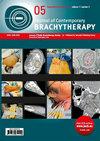为提高前列腺癌低剂量近距离放射治疗患者术后泌尿系统生活质量而应改善的尿路症状:重要性绩效分析
IF 1.1
4区 医学
Q4 ONCOLOGY
引用次数: 0
摘要
目的:评估接受低剂量近距离放射治疗的前列腺癌患者的国际前列腺症状评分和泌尿系统生活质量,并确定为提高术后泌尿系统生活质量而必须改善的下尿路症状以及与下尿路症状相关的因素。进行了重要性表现分析,以确定应优先考虑的下尿路症状,从而提高泌尿系统的生活质量。研究了下尿路症状评分与各因素之间的关系。采用接收者工作特征曲线分析法评估与下尿路症状评分相关的剂量参数,以预测平均评分≥3分。结果:与基线相比,植入后一至九个月的泌尿系统生活质量评分显著提高(p < 0.05)。对 1-9 个月的重要性表现进行分析后发现,尿频、夜尿和尿流无力需要改善。多变量分析表明,每项下尿路症状评分都与基线值有显著相关性(p < 0.001,正相关)。尿频、排空不全、尿急和排尿费力评分与前列腺体积显著相关,而尿流不畅和间歇评分则分别与覆盖前列腺 90% 的剂量和覆盖尿道 90% 的剂量相关(p < 0.05,正相关)。这些剂量的临界值分别为 167.01 Gy 和 136.84 Gy。结论:本研究强调了优先考虑特定下尿路症状对改善术后泌尿系统生活质量的重要性,并确定了有助于个性化治疗计划和目标设定的相关因素,以提高患者满意度。本文章由计算机程序翻译,如有差异,请以英文原文为准。
Urinary tract symptoms that should be improved to enhance post-operative urinary quality of life in patients treated with low-dose-rate brachytherapy for prostate cancer: An importance–performance analysis
Purpose:
To evaluate international prostate symptom score and urinary quality of life in patients with prostate cancer who underwent low-dose-rate brachytherapy, and to identify lower urinary tract symptoms that must be improved to enhance post-operative urinary quality of life and factors associated with lower urinary tract symptoms.
Material and methods:
This study included 193 patients who underwent low-dose-rate brachytherapy alone (145 Gy). Importance–performance analysis was conducted to identify lower urinary tract symptoms that should be prioritized to improve urinary quality of life. Association between lower urinary tract symptom scores and each factor was investigated. Receiver operating characteristic curve analysis was used to evaluate dosimetric parameters related to lower urinary tract symptom score to predict an average score of ≥ 3. Cut-off values were determined.
Results:
One to nine months post-implantation was a period of significantly increased urinary quality of life scores compared with baseline (p < 0.05 each). The importance–performance analysis conducted for 1-9 months revealed that frequency, nocturia, and weak stream required improvement. Multivariate analysis showed that each lower urinary tract symptom score presented a significant association with its baseline value (p < 0.001 each, positive correlation). Frequency, incomplete emptying, urgency, and straining scores were significantly associated with prostate volume, whereas weak stream and intermittency scores were associated with dose covering 90% of the prostate and dose covering 90% of the urethra, respectively (p < 0.05 each, positive correlations). Cut-off values for these doses were 167.01 Gy and 136.84 Gy, respectively.
Conclusions:
This study highlights the importance of prioritizing specific lower urinary tract symptoms for improvement in post-operative urinary quality of life, and identifies the associated factors that can help in personalized treatment planning and goal-setting for better patient satisfaction.
To evaluate international prostate symptom score and urinary quality of life in patients with prostate cancer who underwent low-dose-rate brachytherapy, and to identify lower urinary tract symptoms that must be improved to enhance post-operative urinary quality of life and factors associated with lower urinary tract symptoms.
Material and methods:
This study included 193 patients who underwent low-dose-rate brachytherapy alone (145 Gy). Importance–performance analysis was conducted to identify lower urinary tract symptoms that should be prioritized to improve urinary quality of life. Association between lower urinary tract symptom scores and each factor was investigated. Receiver operating characteristic curve analysis was used to evaluate dosimetric parameters related to lower urinary tract symptom score to predict an average score of ≥ 3. Cut-off values were determined.
Results:
One to nine months post-implantation was a period of significantly increased urinary quality of life scores compared with baseline (p < 0.05 each). The importance–performance analysis conducted for 1-9 months revealed that frequency, nocturia, and weak stream required improvement. Multivariate analysis showed that each lower urinary tract symptom score presented a significant association with its baseline value (p < 0.001 each, positive correlation). Frequency, incomplete emptying, urgency, and straining scores were significantly associated with prostate volume, whereas weak stream and intermittency scores were associated with dose covering 90% of the prostate and dose covering 90% of the urethra, respectively (p < 0.05 each, positive correlations). Cut-off values for these doses were 167.01 Gy and 136.84 Gy, respectively.
Conclusions:
This study highlights the importance of prioritizing specific lower urinary tract symptoms for improvement in post-operative urinary quality of life, and identifies the associated factors that can help in personalized treatment planning and goal-setting for better patient satisfaction.
求助全文
通过发布文献求助,成功后即可免费获取论文全文。
去求助
来源期刊

Journal of Contemporary Brachytherapy
ONCOLOGY-RADIOLOGY, NUCLEAR MEDICINE & MEDICAL IMAGING
CiteScore
2.40
自引率
14.30%
发文量
54
审稿时长
16 weeks
期刊介绍:
The “Journal of Contemporary Brachytherapy” is an international and multidisciplinary journal that will publish papers of original research as well as reviews of articles. Main subjects of the journal include: clinical brachytherapy, combined modality treatment, advances in radiobiology, hyperthermia and tumour biology, as well as physical aspects relevant to brachytherapy, particularly in the field of imaging, dosimetry and radiation therapy planning. Original contributions will include experimental studies of combined modality treatment, tumor sensitization and normal tissue protection, molecular radiation biology, and clinical investigations of cancer treatment in brachytherapy. Another field of interest will be the educational part of the journal.
 求助内容:
求助内容: 应助结果提醒方式:
应助结果提醒方式:


